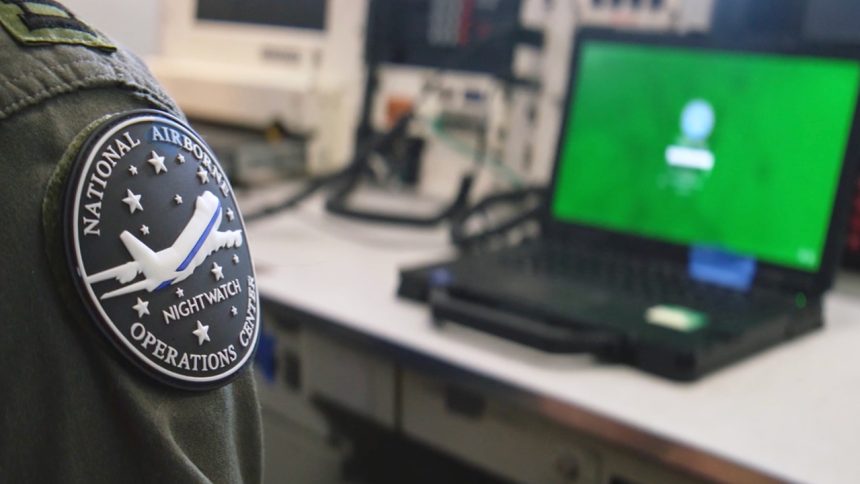Given the sensitivity of this asset, the Air Force rarely shows the interior of the E-4B. However, the 2nd Audiovisual Squadron released B-Roll videos of both the exterior and interior of the distinctive “Doomsday” plane, providing a glimpse into standard day-to-day operations.
The E-4B Nightwatch, also known as the “Doomsday” plane, is one of the most interesting and important aircraft in service with the U.S. Air Force. This is because of its role, as it serves as the National Airborne Operations Center (NAOC) and is a key component of the National Military Command System for the President, the Secretary of Defense and the Joint Chiefs of Staff.
In fact, in case of national emergency or destruction of ground command and control centers, the aircraft provides a highly survivable command, control and communications center to direct U.S. forces, execute emergency war orders, and coordinate actions by civil authorities. In these situations, the Secretary of Defense, the Joint Chiefs of Staff and other top personalities would fly on the E-4B, while the President will fly on the VC-25.
In addition to the NAOC and Nuclear Command, Control and Communications (NC3) missions, the E-4B also supports the Federal Emergency Management Agency, which provides communications and command center capability to relief efforts following natural disasters, such as hurricanes and earthquakes. The E-4B is employed also abroad to support Air Force One’s trips or to transport the Secretary of Defense during his travels.
The aircraft are based at Offutt Air Force Base, Nebraska, and at least one E-4B is always generated as a NAOC and on alert 24 hours a day, 7 days a week. The fleet is managed by Air Force Global Strike Command, which provides aircrew, maintenance, security and communications support, while the NAOC battle staff is provided by the U.S. Strategic Command.
Given the sensitivity of this asset, the Air Force rarely shows the interior of the E-4B. Earlier this month, Hill AFB’s 2D Audiovisual Squadron released two B-Roll videos showing both the exterior and the interior of the aircraft, with the crew performing their day-to-day activities.
The E-4B Nightwatch
The E-4B, a highly modified militarized version of the Boeing 747-200 that serves as National Airborne Operations Center (NAOC) providing a flying command, control and communications center to direct nuclear (and conventional) forces, by receiving, verifying and relaying EAM (Emergency Action Messages). The aircraft is specifically designed to keep American decision makers alive in case of nuclear wars, crisis, or even zombie invasions or alien attacks.
Therefore, the E-4B has to be able to fly through any EMP (electromagnetic pulse) with unharmed systems, so it is protected against the effects of EMP and has an electrical system designed to support advanced electronics and a wide variety of communications equipment. That’s why this highly-modified Boeing 747 does not feature modern glass cockpit but old fashioned, analogue-style avionics which are more resilient to EMPs.
The main deck is divided into six functional areas: a command work area, conference room, briefing room, an operations team work area, communications area and rest area. An E-4B may include seating for up to 111 people, including a joint-service operations team, Air Force flight crew, maintenance and security component, communications team and selected augmentees.
An advanced satellite communications system provides worldwide communication for senior leaders through the airborne operations center. Other improvements include nuclear and thermal effects shielding, acoustic control, an improved technical control facility and an upgraded air-conditioning system for cooling electrical components.
The E-4B evolved from the E-4A, which had been in service since late 1974. The first B model was delivered to the Air Force in January 1980, and by 1985 all aircraft were converted to B models. All E-4B aircraft are assigned to the 595th Command and Control Group at Offutt Air Force Base, Nebraska.
The Survivable Airborne Operations Center
On Apr. 26, 2024, Sierra Nevada Corporation has been awarded a contract for the Survivable Airborne Operations Center (SAOC), the replacement for the E-4B Nightwatch. Similarly to the E-4B, the new SAOC will be a specialized variant of a commercial derivative aircraft, likely the Boeing 747-8.
In fact, while it is not confirmed whether these planes will replace the current E-4 fleet, SNC is acquiring five Boeing 747-8s from Korean Air, with the sale scheduled to be completed in September 2025. The motivation of the acquisition is that the Boeing 747 production ended last year, so the Air Force will have to use second-hand aircraft. The new aircraft is expected to enter active service in 2036.
The new aircraft will feature enhancements to withstand electronic and nuclear threats, including secure communications, self-defense systems, air refueling capabilities, and a modular open systems approach allowing for swift upgrades to enhance its operational effectiveness. While the exact number of aircraft to be procured remains undisclosed, some reports suggest the Air Force intends to acquire between 8 to 10 aircraft for the SAOC fleet.









